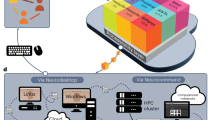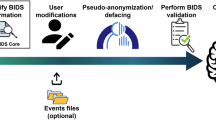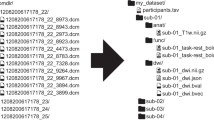Abstract
Mastering the “arcana of neuroimaging analysis”, the obscure knowledge required to apply an appropriate combination of software tools and parameters to analyse a given neuroimaging dataset, is a time consuming process. Therefore, it is not typically feasible to invest the additional effort required generalise workflow implementations to accommodate for the various acquisition parameters, data storage conventions and computing environments in use at different research sites, limiting the reusability of published workflows. We present a novel software framework, Abstraction of Repository-Centric ANAlysis (Arcana), which enables the development of complex, “end-to-end” workflows that are adaptable to new analyses and portable to a wide range of computing infrastructures. Analysis templates for specific image types (e.g. MRI contrast) are implemented as Python classes, which define a range of potential derivatives and analysis methods. Arcana retrieves data from imaging repositories, which can be BIDS datasets, XNAT instances or plain directories, and stores selected derivatives and associated provenance back into a repository for reuse by subsequent analyses. Workflows are constructed using Nipype and can be executed on local workstations or in high performance computing environments. Generic analysis methods can be consolidated within common base classes to facilitate code-reuse and collaborative development, which can be specialised for study-specific requirements via class inheritance. Arcana provides a framework in which to develop unified neuroimaging workflows that can be reused across a wide range of research studies and sites.












Similar content being viewed by others
References
Abadi, M., Barham, P., Chen, J., Chen, Z., Davis, A., Dean, J., Devin, M., Ghemawat, S., Irving, G., Isard, M., et al. (2016). TensorFlow: a system for large-scale machine learning. In Proceedings of the 12th USENIX symposium on operating systems design and implementation (OSDI ’16), Savannah, GA, USA (p. 21).
Achterberg, H.C., Koek, M., Niessen, W.J. (2016). Fastr: a workflow engine for advanced data flows in medical image analysis. Frontiers in ICT 3. https://doi.org/10.3389/fict.2016.00015.
Amstutz, P., Crusoe, M.R., Tijanić, N., Chapman, B., Chilton, J., Heuer, M., Kartashov, A., Leehr, D., Ménager, H, Nedeljkovich, M., Scales, M., Soiland-Reyes, S., Stojanovic, L. (2016). Common Workflow Language, v1.0. https://doi.org/10.6084/m9.figshare.3115156.v2.
Avants, B.B., Tustison, N.J., Song, G., Cook, P.A., Klein, A., Gee, J.C. (2011). A reproducible evaluation of ANTs similarity metric performance in brain image registration. NeuroImage, 54(3), 2033–2044. https://doi.org/10.1016/j.neuroimage.2010.09.025.
Book, G.A., Anderson, B.M., Stevens, M.C., Glahn, D.C., Assaf, M., Pearlson, G.D. (2013). Neuroinformatics database (NiDB)–a modular, portable database for the storage, analysis, and sharing of neuroimaging data. Neuroinformatics, 11(4), 495–505. https://doi.org/10.1007/s12021-013-9194-1.
Cox, R.W. (1996). AFNI: software for analysis and visualization of functional magnetic resonance neuroimages. Computers and Biomedical Research, an International Journal, 29(3), 162–173.
Cusack, R., Vicente-Grabovetsky, A., Mitchell, D.J., Wild, C.J., Auer, T., Linke, A.C., Peelle, J.E. (2015). Automatic analysis (aa): efficient neuroimaging workflows and parallel processing using Matlab and XML. Frontiers in Neuroinformatics. https://doi.org/10.3389/fninf.2014.00090.
Das, S., Zijdenbos, A.P., Harlap, J., Vins, D., Evans, A.C. (2012). LORIS: a web-based data management system for multi-center studies. Frontiers in Neuroinformatics 5(January):1–11, iSBN: 1662–5196, https://doi.org/10.3389/fninf.2011.00037.
Esteban, O., Markiewicz, C., Blair, R.W., Moodie, C., Isik, A.I., Erramuzpe Aliaga, A., Kent, J., Goncalves, M., DuPre, E., Snyder, M., Oya, H., Ghosh, S., Wright, J., Durnez, J., Poldrack, R., Gorgolewski, K.J. (2018). FMRIPrep: a robust preprocessing pipeline for functional MRI. bioRxiv https://doi.org/10.1101/306951.
Friston, K. (2007). Statistical parametric mapping. Elsevier https://doi.org/10.1016/B978-0-12-372560-8.X5000-1.
Furlani, J.L. (1991). Modules: providing a flexible user environment. In Proceedings of the fifth large installation systems administration conference (LISA V) (pp. 141–152).
Gorgolewski, K. (2019). BIDS extension proposal 3 (BEP003): common derivatives. https://docs.google.com/document/d/1Wwc4A6Mow4ZPPszDIWfCUCRNstn7d_zzaWPcfcHmgI4/edit?usp=embed_facebook.
Gorgolewski, K., Burns, C.D., Madison, C., Clark, D., Halchenko, Y.O., Waskom, M.L., Ghosh, S.S. (2011). Nipype: a flexible, lightweight and extensible neuroimaging data processing framework in python. Frontiers in Neuroinformatics, 5, 13. https://doi.org/10.3389/fninf.2011.00013.
Gorgolewski, K.J., Auer, T., Calhoun, V.D., Craddock, R.C., Das, S., Duff, E.P., Flandin, G., Ghosh, S.S., Glatard, T., Halchenko, Y.O., Handwerker, D.A., Hanke, M., Keator, D., Li, X., Michael, Z., Maumet, C., Nichols, B.N., Nichols, T.E., Pellman, J., Poline, J.B., Rokem, A., Schaefer, G., Sochat, V., Triplett, W., Turner, J.A., Varoquaux, G., Poldrack, R.A. (2016). The brain imaging data structure, a format for organizing and describing outputs of neuroimaging experiments. Scientific data 3:160,044, https://doi.org/10.1038/sdata.2016.44.
Grabner, G., Janke, A.L., Budge, M.M., Smith, D., Pruessner, J., Collins, D.L. (2006). Symmetric atlasing and model based segmentation: an application to the hippocampus in older adults. In R. Larsen, M. Nielsen, J. Sporring (Eds.) Medical image computing and computer-assisted intervention – MICCAI 2006. Heidelberg, Lecture Notes in Computer Science (pp. 58–66). Berlin: Springer.
Halchenko, Y., Hanke, M., Poldrack, B., Meyer, K., Solanky, D.S., Alteva, G., Gors, J., MacFarlane, D., Olaf Häusler, C., Olson, T., Waite, A., De La Vega, A., Sochat, V, Keshavan, A., Ma, F., Christian, H., Poelen, J., Skytén, K., Visconti di Oleggio Castello, M., Hardcastle, N., Stoeter, T., C Lau, V., Markiewicz, C.J. (2019). datalad/datalad 0.11.5.
Kennedy, D.N. (2018). Neuroimaging neuroinformatics: sample size and other evolutionary topics. Neuroinformatics, 16(2), 149–150. https://doi.org/10.1007/s12021-018-9379-8.
Marcus, D.S., Olsen, T.R., Ramaratnam, M., Buckner, R.L. (2007). The extensible neuroimaging archive toolkit. Neuroinformatics, 5(1), 11–33. https://doi.org/10.1385/NI:5:1:11.
Maumet, C. (2018). Tools and standards to make neuroimaging derived data reusable. In Neuroinformatics 2018, Montreal, Canada, http://www.hal.inserm.fr/inserm-01886089.
Moore, D., Budd, R., Wright, W. (2008). Professional python frameworks: Web 2.0 Programming with Django and Turbogears. Indianapolis: Wiley Publishing, Inc.
Raymond, E.S. (1999). The cathedral and the Bazaar. O’Reilly Media, p. 30.
Schreiber, J., Hoffstaedter, F., Deepu, R., Orth, B., Lippert, T., Amunts, K., Eickhoff, S., Caspers, S. (2018). Using a multi-Petaflop supercomputer for pushing neuroimaging analytics to the next level. In Proceedings of organisation for human brain mapping 2018, Singapore, Singapore.
Scott, A., Courtney, W., Wood, D., de la Garza, R., Lane, S., King, M., Wang, R., Roberts, J., Turner, J.A., Calhoun, V.D. (2011). COINS: an innovative informatics and neuroimaging tool suite built for large heterogeneous datasets. Frontiers in Neuroinformatics, 5, 33. https://doi.org/10.3389/fninf.2011.00033.
Smith, S.M., Jenkinson, M., Woolrich, M.W., Beckmann, C.F., Behrens, T.E.J., Johansen-Berg, H., Bannister, P.R., De Luca, M., Drobnjak, I., Flitney, D.E., Niazy, R.K., Saunders, J., Vickers, J., Zhang, Y., De Stefano, N., Brady, J.M., Matthews, P.M. (2004). Advances in functional and structural MR image analysis and implementation as FSL. NeuroImage 23 Suppl, 1, S208–219. https://doi.org/10.1016/j.neuroimage.2004.07.051.
Sudlow, C., Gallacher, J., Allen, N., Beral, V., Burton, P., Danesh, J., Downey, P., Elliott, P., Green, J., Landray, M., Liu, B., Matthews, P., Ong, G., Pell, J., Silman, A., Young, A., Sprosen, T., Peakman, T., Collins, R. (2015). UK Biobank: an open access resource for identifying the causes of a wide range of complex diseases of middle and old age. PLoS Medicine 12(3), https://doi.org/10.1371/journal.pmed.1001779.
Thompson, P.M., Stein, J.L., Medland, S.E., Hibar, D.P., Vasquez, A.A., Renteria, M.E., Toro, R., Jahanshad, N., Schumann, G., Franke, B., et al. (2014). The ENIGMA consortium: large-scale collaborative analyses of neuroimaging and genetic data. Brain Imaging and Behavior, 8(2), 153–182. https://doi.org/10.1007/s11682-013-9269-5.
Tournier, J.D., Calamante, F., Connelly, A. (2010). Improved probabilistic streamlines tractography by 2nd order integration over fibre orientation distributions. In Proceedings of the international society for magnetic resonance in medicine, (Vol. 18 p. 1670).
Tournier, J.D., Calamante, F., Connelly, A. (2012). MRtrix: diffusion tractography in crossing fiber regions. International Journal of Imaging Systems and Technology, 22(1), 53–66. https://doi.org/10.1002/ima.22005.
Van Essen, D.C., Ugurbil, K., Auerbach, E., Barch, D., Behrens, T.E.J., Bucholz, R., Chang, A., Chen, L., Corbetta, M., Curtiss, S.W., Della Penna, S., Feinberg, D., Glasser, M.F., Harel, N., Heath, A.C., Larson-Prior, L., Marcus, D., Michalareas, G., Moeller, S., Oostenveld, R., Petersen, S.E., Prior, F., Schlaggar, B.L., Smith, S.M., Snyder, A.Z., Xu, J., Yacoub, E., WU-Minn HCP Consortium. (2012). The human connectome project: a data acquisition perspective. NeuroImage, 62(4), 2222–2231. https://doi.org/10.1016/j.neuroimage.2012.02.018.
Ward, P.G., Ferris, N.J., Raniga, P., Ng, A.C., Barnes, D.G., Dowe, D.L., Egan, G.F. (2017). Vein segmentation using shape-based Markov random fields. In 2017 IEEE 14th international symposium on biomedical imaging (ISBI 2017) (pp. 1133–1136): IEEE.
Ward, P.G.D., Ferris, N.J., Raniga, P., Dowe, D.L., Ng, A.C.L., Barnes, D.G., Egan, G.F. (2018). Combining images and anatomical knowledge to improve automated vein segmentation in MRI. NeuroImage, 165, 294–305. https://doi.org/10.1016/j.neuroimage.2017.10.049.
White, T. (2012). Hadoop: the definitive guide. O’Reilly Media Inc.
Wilkinson, M.D., Dumontier, M., Aalbersberg, I.J., Appleton, G., Axton, M., Baak, A., Blomberg, N., Boiten, J.-W., da Silva Santos, L.B., Bourne, P.E., Bouwman, J., Brookes, A.J., Clark, T., Crosas, M., Dillo, I., Dumon, O., Edmunds, S., Evelo, C.T., Finkers, R., Gonzalez-Beltran, A., Gray, A.J.G., Groth, P., Goble, C., Grethe, J.S., Heringa, J., ’t Hoen, P.A.C., Hooft, R., Kuhn, T., Kok, R., Kok, J., Lusher, S.J., Martone, M.E., Mons, A., Packer, A.L., Persson, B., Rocca-Serra, P., Roos, M., van Schaik, R., Sansone, S.-A., Schultes, E., Sengstag, T., Slater, T., Strawn, G., Swertz, M.A., Thompson, M., van der Lei, J., van Mulligen, E., Velterop, J., Waagmeester, A., Wittenburg, P., Wolstencroft, K., Zhao, J., Mons, B. (2016). The FAIR Guiding Principles for scientific data management and stewardship. Scientific Data, 3, 160018.
Yacoub, S.M., & Ammar, H.H. (2004). Pattern-oriented analysis and design: composing patterns to design software systems. Addison-Wesley Professional, google-Books-ID: dbU4ggCbqd4C.
Yoo, A.B., Jette, M.A., Grondona, M. (2003). SLURM: simple linux utility for resource management. In D. Feitelson, L. Rudolph, U. Schwiegelshohn (Eds.) Job scheduling strategies for parallel processing. Heidelberg, Lecture Notes in Computer Science (pp. 44–60). Berlin: Springer.
Acknowledgements
The authors acknowledge the facilities and scientific and technical assistance of the National Imaging Facility, a National Collaborative Research Infrastructure Strategy (NCRIS) capability, at Monash Biomedical Imaging, Monash University. The “transparent repository” feature of Arcana was inspired by in-house software written by Parnesh Raniga while he was employed at Monash University prior to 2016.
Author information
Authors and Affiliations
Corresponding author
Additional information
Publisher’s Note
Springer Nature remains neutral with regard to jurisdictional claims in published maps and institutional affiliations.
Electronic supplementary material
ESM 1
(PY 10.2 KB)
Rights and permissions
About this article
Cite this article
Close, T.G., Ward, P.G.D., Sforazzini, F. et al. A Comprehensive Framework to Capture the Arcana of Neuroimaging Analysis. Neuroinform 18, 109–129 (2020). https://doi.org/10.1007/s12021-019-09430-1
Published:
Issue Date:
DOI: https://doi.org/10.1007/s12021-019-09430-1




